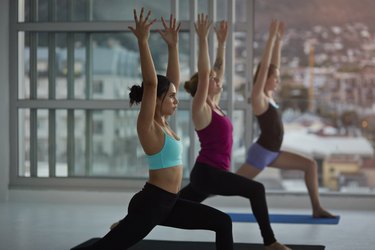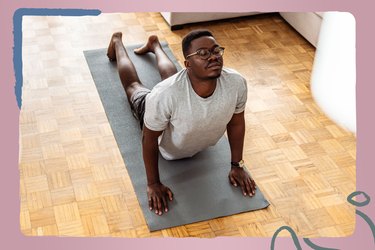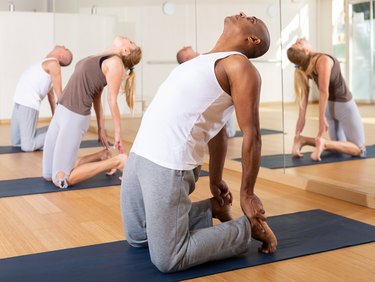
Yoga is one of the simplest exercise modalities to get into. All you really need is a few feet of free space to get started with yoga, and you can practice from the comfort of your own home. So, it's no surprise millions of people around the world practice it.
The number of yogis is constantly growing — the industry accounts for more than $100 billion in the global economy. But how many people actually practice consistently? What are the benefits of regular yoga? And is it safe at all stages of life?
Video of the Day
Video of the Day
Read on to learn these yoga statistics and more.
Global Yoga Prevalence
There are millions of people around the wold who practice yoga, which originated in India.
- There are more than 300 million yoga practitioners around the world, according to MedAlertHelp, a health and medical product organization.
- There are about 300,000 to 460,000 yogis in the United Kingdom.
- There are more than 754 yoga facilities in Beijing.
- 40.5% of global yoga practitioners practice during the day, according to The Global Yoga Survey conducted by DoYou, a health and fitness app.
- 42.2% practice at night.
- 30.2% practice at irregular times.
- 80% of survey respondents spend at least 30 minutes (or more) doing yoga.
Yoga Statistics in India
- About 11.8% of people in India practice yoga, according to a February 2020 study in Medicines.
- Of those who practice, about 6% are male and 5% are female. (Note: The terms we use throughout for sex and gender reflect the language used in each cited source.)
- Of those who practice, about 6% live in urban areas and about 5% live in rural regions.
- According to the Pew Research Center, these are the percentages of people who practice yoga within the country's most popular religious groups:
- 61% of people who are Jain
- 50% of people who are Sikh
- 38% of people who are Indian Buddhists
- 36% of people who are Hindus
- 29% of people who are Muslim
- 24% of people who are Christian
Yoga Statistics in Australia
- Between 1.7% and 2.9% of the Australian adult population participates in yoga, according to a July 2012 study in the International Journal of Yoga.
- 71.9% of survey respondents started yoga to increase their health and fitness.
- 86.5% continued their practice to increase flexibility and muscle tone.
- 61% of yoga sessions in Australia are either Vinyasa yoga or Yin-style yoga (more on that below).
- 39% of yoga workouts in Australia are gentler sequences involving breathing techniques and meditation.
Yoga Statistics in Canada
- About 21% of people in Canada practice yoga, according to Leger, a Canadian market research and analytics company.
- 35% of people in Canada who practice are between the ages of 18 and 34.
- 16% fewer people in Quebec do yoga compared to the rest of the country.
Yoga Demographics in America
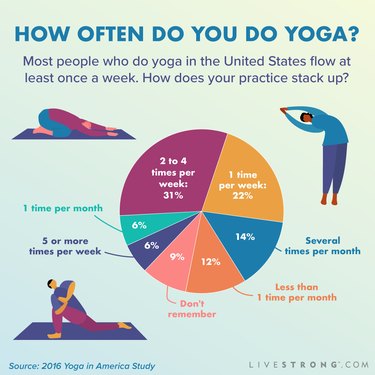
Nearly 28% of all Americans have tried a yoga class at some point in their lives, according to the 2016 Yoga in America Study conducted by Yoga Journal and Yoga Alliance. And that number is only growing.
- The number of yoga practitioners grew from 20.4 million in 2012 to 36 million in 2016, according to the 2016 Yoga in America Study.
- 33% of Americans have tried yoga on their own at least once.
- 74% of yogis have been practicing for less than five years.
- 98% of practitioners are beginner to intermediate level.
- Most people who do yoga practice at least once a week:
- 5 or more times/week: 6%
- 2 to 4 times/week: 31%
- 1 time/week: 22%
- Several times/month: 14%
- 1 time/month: 6%
- Less than 1 time/month: 12%
- Don't remember: 9%
- Most U.S. yogis are relatively new to the practice. Here is a look at how long people have been doing yoga:
- 0 to 1 year: 30%
- 1 to 5 years: 44%
- 6 to 10 years: 17%
- 10 years or longer: 7%
- American yogis are relatively equally spread across regions:
- Northeast: 23%
- Midwest: 23%
- South: 32%
- West: 22%
- In 2021, yoga was the second most popular form of exercise, according to the ClassPass 2021 Fitness and Beauty Trends Report.
- Livestream yoga was also one of the most popularly booked classes on the fitness class and health club app.
- 40% of people like to use calming forms of exercise, like yoga, on a high-stress day.
Yoga Statistics by Age
Yoga is a great activity for all ages and fitness levels. But most people who practice yoga are middle-aged — and many of these people have kids who practice yoga, too, according to the 2016 Yoga in America Study.
- About 19% of yoga practitioners are between the ages of 18 and 29.
- 23% are between the ages of 30 and 39.
- 20% are between 40 and 49.
- 17% are between 50 and 59.
- 21% are 60 and older.
- 37% of people who practice have kids under the age of 18 who have practiced yoga.
Yoga Statistics by Sex
Yoga is significantly more popular among women than men, according to the 2016 Yoga in America Study. But the number of male practitioners in the U.S. more than doubled between 2012 and 2016.
- According to the 2016 Yoga in America Study, about 72% of yoga practitioners are female and 28% are male.
- The number of men who do yoga grew from 4 million in 2012 to 10 million in 2016, according to Harvard Health Publishing.
Yoga Health Statistics
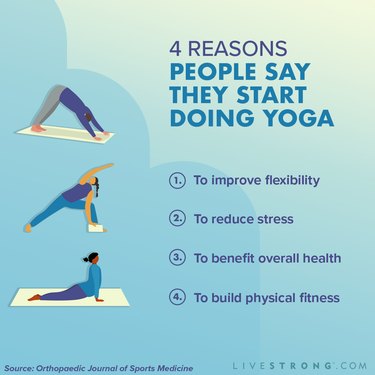
It's probably no surprise that yoga has some pretty amazing health benefits. And yogis are more likely to enjoy other types of exercise, too!
- Yogis are 20% more likely to feel like they have improved balance and range of motion than those who don't practice, according to the 2016 Yoga in America Study.
Take a look at the chart below to learn a few benefits yogis say they experience compared to non-practitioners.
Comparing Benefits Between Yogis and Non-Practitioners
Practitioner | Non-Practitioner | |
|---|---|---|
Having Good Balance | 80% | 65% |
Feeling Strong | 75% | 57% |
Sense of Mental Clarity | 86% | 77% |
- 94% of adults who practice yoga say they do it to improve their overall wellness, according to the National Center for Complementary and Integrative Health.
- 17.5% of people practice yoga to address specific health conditions.
- As little as 3 months of consistent yoga practice can help reduce stress levels, according to a small May 2017 study in the International Journal of Yoga.
- There were about 25,950 yoga-related injuries between 2001 and 2014, according to a November 2016 study in the Orthopaedic Journal of Sports Medicine.
- 46.6% of these injuries were in the trunk of the body.
- 45% of yoga injuries were sprains or strains.
- 79% of yogis also participate in other sports, like running, cycling or strength training, according to the 2016 Yoga in America Study.
- According to the above-mentioned study, these are the top health reasons why people start yoga:
- 61% of people start to improve flexibility
- 56% of people start for stress relief
- 49% of people start for overall health
- 44% of people start to improve physical fitness
- People who do yoga are 20% more likely to have a positive image of their physical and mental health than non-practitioners, according to Harvard Health Publishing.
- According to the 2022 National Health Interview Survey, the use of yoga as a way to manage pain has more than doubled since 2002.
Statistics About Types of Yoga
There are more than 800 different types of yoga, according to Harvard Health Publishing, many of which began in India. Today, several different styles include modifications for various life stages, like prenatal yoga.
- According to India-based fitness and wellness app Healthifyme, eight of the most popular types are:
- Ashtanga yoga
- Hatha yoga
- Hot yoga
- Iyengar yoga
- Kundalini yoga
- Power yoga
- Restorative yoga
- Vinyasa yoga
- According to ClassPass' 2021 report, these yoga styles are among the most popular calming and restorative workouts:
- Reformer Pilates
- Hot yoga
- Yin yoga
- Mat Pilates
- Restorative yoga
- Hatha yoga
- Ballet
Prenatal Yoga Statistics
- Thirty minutes of prenatal yoga is generally considered safe for most pregnant people, according to the American Pregnancy Association.
- According to the National Association of Complementary and Alternative Medicine, there are 20 basic postures in prenatal yoga:
- Bent Knee Relaxation Pose With Pelvic Tilting
- Bridge Pose
- Shoulder Stretch on Chair
- Cat Stretch Pose
- Cat Stretch Pose
- Standing Bent Knee Pose
- Back Rest to Wall
- Bent Knee Leg Stretch
- Bent Knee Thigh Stretch
- Straight Leg Stretch
- Standing Straight Leg Stretch
- Hero's Pose
- Reclining Hero's Pose
- Triangle Pose
- Side Angle Pose
- Squat to Wall
- Butterfly Pose
- Wide Angle Pose
- Bent Knee Twist
- Side Lying Pose
Yoga Industry Statistics
The yoga industry is a bigger economy-booster than you may realize. Each year, U.S. yogis spend billions of dollars on clothes, equipment and classes, according to the 2016 Yoga in America Study.
- As of 2022, there are about 40,582 yoga and Pilates studios in the country, according to IBISWorld, an industry analytics and market research company.
- This is a 4.6% increase from the previous year.
- Americans spent about $16 billion on yoga clothes, equipment, classes and accessories in 2016. Here's how all that spending breaks down:
- Yoga classes: $5,800,000
- Yoga clothes: $4,600,000
- Yoga equipment: $3,600,000
- Yoga accessories: $2,800,000
- 91% of yoga studio owners value instructors with a Yoga Alliance credential.
- 99% of studio owners value continued learning and training for their instructors.
- Almost 50% of yoga studio owners have owned their facility for more than six years.
- 62% of studio owners dedicate their space entirely to yoga.
- Almost 40% of owners have between 100 and 500 students per week.
Yoga Facts and History
Yoga has been around for thousands of years and doesn't actually have one founder. Instead, the practice was developed through different classical texts.
- Classical yoga was a part of the Rigveda, a book that was written about 8,000 to 10,000 years ago, according to the Art of Living, a non-profit organization that researches stress to improve people's overall wellbeing.
- The yoga sutras, a text written about 5,000 years ago, emphasize eight "limbs" or parts of yoga:
- Yama (social ethics)
- Niyama (personal ethics)
- Asana (postures)
- Pranayama (life force)
- Pratyhara (turning the senses inward)
- Dharma (one-pointed focus)
- Dhyana (meditation)
- Samadhi (merging with the self)
- Yoga was invented between 500 B.C. and 800 A.D., according to the Ministry of External Affairs for the Government of India.
- MedAlertHelp: "34 Life-Altering Yoga Statistics & Facts for a Balanced 2022"
- DoYou: "The Global Yoga Survey 2021"
- International Journal of Yoga: "Yoga in Australia: Results of a National Survey"
- Medicines: "Knowledge, Attitude, and Practice of Yoga in Rural and Urban India, KAPY 2017: A Nationwide Cluster Sample Survey"
- Pew Research Center: "Most Indians, Including Most Hindus, Do Not Practice Yoga"
- Leger: "Yoga's Popularity Continues"
- Yoga Journal and Yoga Alliance: "2016 Yoga in America Study"
- ClassPass: "ClassPass Beauty and Fitness Trends: What To Expect In 2022"
- Harvard Health Publishing: "New Survey Reveals the Rapid Rise of Yoga — and Why Some People Still Haven’t Tried It"
- National Center for Complementary and Integrative Health: "Yoga: What You Need To Know"
- International Journal of Yoga: "Longitudinal and Immediate Effect of Kundalini Yoga on Salivary Levels of Cortisol and Activity of Alpha-Amylase and Its Effect on Perceived Stress"
- Orthopaedic Journal of Sports Medicine: "Yoga-Related Injuries in the United States From 2001 to 2014"
- 2012 National Health Interview Survey: "Americans who practice Yoga report better wellness, health behaviors"
- Harvard Health Publishing: "Yoga for the Body and Mind"
- Healthifyme: "Different Types of Yoga: A Complete Guide"
- National Association of Complementary and Alternative Medicine: "Prenatal Yoga"
- American Pregnancy Association: "Prenatal Yoga"
- IBISWorld: "Pilates & Yoga Studios in the US"
- Ministry of External Affairs: "Yoga: Its Origin, History and Development"
- Art of Living: "A Brief History of Yoga"
